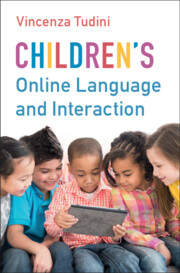Book contents
- Children’s Online Language and Interaction
- Children’s Online Language and Interaction
- Copyright page
- Dedication
- Contents
- Figures and Tables
- Preface
- Acknowledgements
- Transcription Conventions
- 1 What Is Talk and Why Do Children Need It?
- 2 Beyond Emotions: Emoji Talk
- 3 Penguin Talk
- 4 Video Game Talk
- 5 Minecraft Interaction
- 6 Children’s YouTube Comments on Ethan Gamer
- 7 Online Grooming Talk
- 8 Summary of Findings, Implications, and Guidelines
- Appendix: Data Table
- References
- Index
7 - Online Grooming Talk
Published online by Cambridge University Press: 19 December 2024
- Children’s Online Language and Interaction
- Children’s Online Language and Interaction
- Copyright page
- Dedication
- Contents
- Figures and Tables
- Preface
- Acknowledgements
- Transcription Conventions
- 1 What Is Talk and Why Do Children Need It?
- 2 Beyond Emotions: Emoji Talk
- 3 Penguin Talk
- 4 Video Game Talk
- 5 Minecraft Interaction
- 6 Children’s YouTube Comments on Ethan Gamer
- 7 Online Grooming Talk
- 8 Summary of Findings, Implications, and Guidelines
- Appendix: Data Table
- References
- Index
Summary
Chapter 7 introduces the topic of online grooming of children, which is facilitated by text chat due to the anonymity it provides predators. It examines one published example of chat interaction between an identified offender and his young teenage victim, which provides new insights on the interactional behaviours of predators when attempting to groom children, in the early nonsexual stages of online relationships. The analysis of this single episode demonstrates that online predators may use self-disclosure and personal announcements intended to provoke interest and sympathy in their victims. This has the effect of the victim letting down her guard and submitting personal self-disclosures of her own. Specifically, initial grooming trajectories may include getting acquainted behaviours, small talk, troubles announcements, self-disclosures involving personal life, expression of feelings; requests for information about relationships and discussion of sexual interests. While not evident in the examined chat interaction, exchange of photographs is also known to be common. Chapter findings suggest that it may be possible to recognize online predators and protect children, in early nonsexual stages of grooming, though further conversation analytical research across a variety of contexts and age groups is urgently needed.
Keywords
- Type
- Chapter
- Information
- Children's Online Language and Interaction , pp. 159 - 176Publisher: Cambridge University PressPrint publication year: 2025

